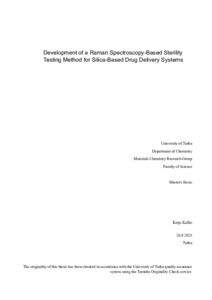Development of a Raman Spectroscopy-Based Sterility Testing Method for Silica-Based Drug Delivery Systems
Kallio, Katja (2025-10-10)
Development of a Raman Spectroscopy-Based Sterility Testing Method for Silica-Based Drug Delivery Systems
Kallio, Katja
(10.10.2025)
Julkaisu on tekijänoikeussäännösten alainen. Teosta voi lukea ja tulostaa henkilökohtaista käyttöä varten. Käyttö kaupallisiin tarkoituksiin on kielletty.
avoin
Julkaisun pysyvä osoite on:
https://urn.fi/URN:NBN:fi-fe20251114108047
https://urn.fi/URN:NBN:fi-fe20251114108047
Tiivistelmä
Microbial contamination can pose a critical risk to the safety and efficacy of both sterile and non-sterile pharmaceutical products. Microorganisms can compromise product quality by causing contamination, degradation, and reduce the efficacy of the drug. While current pharmacopoeial methods offer standardized procedures for microbial testing, they are not suitable for all formulations. For example, the methods described are not suitable for drug delivery systems such as DelSiTech™ silica-based technologies. These limitations emphasize the need for alternative, rapid, and non-destructive analytical techniques.
This thesis investigates the potential of Raman spectroscopy as a microbiological quality control method for silica-based pharmaceutical products. Raman spectroscopy is a vibrational spectroscopic technique based on inelastic scattering of monochromatic light, typically from a laser, as it interacts with molecular bonds in the sample. Raman spectroscopy provides molecular fingerprints and has shown promise in detecting and identifying microorganisms, even at the single-cell level. Because each microorganism has a distinct biochemical fingerprint, which is determined by its proteins, nucleic acids, lipids, and carbohydrates, Raman spectroscopy offers a highly specific, label-free method for microbial identification.
Raman spectroscopy is label-free, non-destructive, and there is no need for extensive sample preparation. Unlike with culture-based traditional microbial identification methods, which may require days for microbial growth, with Raman measurements results can be obtained in minutes. Additionally, the technique is well suited for complex sample environments, where conventional techniques fail or interfere with analysis. These qualities make Raman spectroscopy a suitable candidate for sterility assessment even in advanced formulations.
The experimental work involves Raman analysis of silicon oxide, selected microorganisms, and one active pharmaceutical ingredient (API). Three representative microorganisms were studied: Bacillus subtilis cf.
spizizenii (Gram-positive), Pseudomonas chlororaphsis (Gram-negative), and Aspergillus versicolor (yeast). These were analysed in different physical states: lyophilized on cellulose filters, in liquid culture and dissolved in ammonium bifluoride (NH₄HF₂), which is neutralized with silica. Serial dilutions of each microorganism were prepared to determine the detection limits.
All measurements were carefully optimized with respect to laser wavelength, laser power, exposure time, magnification, and substrate material. A variety of substrates—including quartz, stainless steel, and calcium fluoride (CaF₂) were tested to evaluate their effect on signal-to-noise ratio and background interference.
This thesis investigates the potential of Raman spectroscopy as a microbiological quality control method for silica-based pharmaceutical products. Raman spectroscopy is a vibrational spectroscopic technique based on inelastic scattering of monochromatic light, typically from a laser, as it interacts with molecular bonds in the sample. Raman spectroscopy provides molecular fingerprints and has shown promise in detecting and identifying microorganisms, even at the single-cell level. Because each microorganism has a distinct biochemical fingerprint, which is determined by its proteins, nucleic acids, lipids, and carbohydrates, Raman spectroscopy offers a highly specific, label-free method for microbial identification.
Raman spectroscopy is label-free, non-destructive, and there is no need for extensive sample preparation. Unlike with culture-based traditional microbial identification methods, which may require days for microbial growth, with Raman measurements results can be obtained in minutes. Additionally, the technique is well suited for complex sample environments, where conventional techniques fail or interfere with analysis. These qualities make Raman spectroscopy a suitable candidate for sterility assessment even in advanced formulations.
The experimental work involves Raman analysis of silicon oxide, selected microorganisms, and one active pharmaceutical ingredient (API). Three representative microorganisms were studied: Bacillus subtilis cf.
spizizenii (Gram-positive), Pseudomonas chlororaphsis (Gram-negative), and Aspergillus versicolor (yeast). These were analysed in different physical states: lyophilized on cellulose filters, in liquid culture and dissolved in ammonium bifluoride (NH₄HF₂), which is neutralized with silica. Serial dilutions of each microorganism were prepared to determine the detection limits.
All measurements were carefully optimized with respect to laser wavelength, laser power, exposure time, magnification, and substrate material. A variety of substrates—including quartz, stainless steel, and calcium fluoride (CaF₂) were tested to evaluate their effect on signal-to-noise ratio and background interference.
